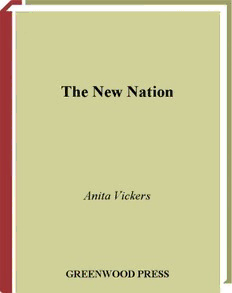Table Of ContentThe New Nation
Anita Vickers
GREENWOOD PRESS
The
New
Nation
The
New
Nation
Anita Vickers
AmericanPopularCultureThroughHistory
RayB.Browne,SeriesEditor
GREENWOODPRESS
Westport,Connecticut • London
LibraryofCongressCataloging-in-PublicationData
Vickers,Anita,1952–
Thenewnation / AnitaVickers.
p.cm.—(Americanpopularculturethroughhistory)
Includesbibliographicalreferencesandindex.
ISBN0–313–31264–8(alk.paper)
1. UnitedStates—Civilization—1783–1865. 2. Popularculture—United
States—History—18thcentury. 3. Popularculture—UnitedStates—History—19th
century. I. Title. II. Series.
E164.V53 2002
973—dc21 2001054701
BritishLibraryCataloguinginPublicationDataisavailable.
Copyright(cid:1)2002byAnitaVickers
Allrightsreserved.Noportionofthisbookmaybe
reproduced,byanyprocessortechnique,withoutthe
expresswrittenconsentofthepublisher.
LibraryofCongressCatalogCardNumber:2001054701
ISBN:0–313–31264–8
Firstpublishedin2002
GreenwoodPress,88PostRoadWest,Westport,CT06881
AnimprintofGreenwoodPublishingGroup,Inc.
www.greenwood.com
PrintedintheUnitedStatesofAmerica
TM
Thepaperusedinthisbookcomplieswiththe
PermanentPaperStandardissuedbytheNational
InformationStandardsOrganization(Z39.48–1984).
10 9 8 7 6 5 4 3 2 1
Contents
Series Foreword by Ray B. Browne vii
Introduction ix
Timeline of Popular Culture Events xiii
Part One Life and Youth During the New
Nation 1
1 Everyday America 3
2 World of Youth 39
Part Two Popular Culture of the New Nation 53
3 Advertising 55
4 Architecture 65
5 Fashion 89
6 Food 107
7 Leisure Activities 123
8 Literature 149
9 Music 179
10 Performing Arts 199
vi Contents
11 Travel 217
12 Visual Arts 235
Cost of Products in the New Nation 257
Notes 261
Further Reading 277
Index 285
Series Foreword
Popularcultureisthesystemofattitudes,behavior,beliefs,customs,and
tastes that defines the people of any society. It is the entertainments,
diversions, icons, rituals, and actions that shape the everyday world. It
is what we do while we are awake and what we dream about whilewe
areasleep.Itisthewayoflifeweinherit,practice,change,andthenpass
on to our descendants.
Popular culture is an extension of folk culture, the culture of the peo-
ple. Withtheriseofelectronicmediaandtheincreaseincommunication
in American culture, folk culture expanded into popular culture—the
daily way of life as shaped by the popular majority of society. Especially
in a democracy like the United States, popular culture has become both
the voice of the people and the force that shapes the nation. In 1782, the
French commentator Hector St. Jean de Cre`vecoeur asked in his Letters
fromanAmericanFarmer,“WhatisanAmerican?”Heansweredthatsuch
a person is the creation of America and is in turn the creator of the
country’s culture. Indeed, notions of the American Dream have been
long grounded in the dream of democracy—that is, government by the
people, or popular rule. Thus, popular culture is tied fundamentally to
America and the dreams of its people.
Historically, culture analysts have tried to fine-tune culture into two
categories: “elite”—the elements of culture (fine art, literature, classical
music, gourmet food, etc.) that supposedly define the best of society—
and “popular”—the elements of culture (comic strips, best-sellers, pop
music, fast food, etc.) that appeal to society’s lowest common denomi-
nator. The so-called educated person approved of elite culture and
scoffed at popular culture. This schismfirstbegantodevelopinwestern
viii SeriesForeword
Europe in the fifteenth century when the privileged classes tried to dis-
cover and develop differences in societies based on class, money, privi-
lege, and lifestyles. Like many aspects of European society, the debate
betweeneliteandpopularculturescametotheUnitedStates.Theupper
class in America, for example, supported museums and galleries that
would exhibit the finer things in life, that would elevate people. As the
twenty-firstcenturyemerges,however,thedistinctionsbetweenpopular
cultureandelitistculturehaveblurred.Thebluessongs(oncedenigrated
as “race music”) of Robert Johnson are now revered by musicologists;
architecturalstudentsstudybuildingsinLasVegas,Nevada,asexamples
of what Robert Venturi called the “kitsch of high capitalism”; sports-
writer Gay Taleseand heavyweightboxingchampFloydPattersonwere
co-panelists at a 1992 State University of New York–New Paltz sympo-
sium on literature and sport. The examples go on and on, but the one
commonality that emerges is the role of popular culture as a model for
the American Dream, the dream to pursue happinessand a better,more
interesting life.
To trace the numerous ways in which popular culture has evolved
throughoutAmericanhistory,wehavedividedthevolumesinthisseries
into chronological periods—historical eras until the twentieth century,
thedecadesbetween1900and2000.Ineachvolume,theauthorexplores
the specific details of popular culture that reflect and informthegeneral
undercurrentsofthetime.Ourpurpose,then,istopresenthistoricaland
analytical panoramas that reach both backward into America’s past and
forward to her collective future. In viewing these panoramas, we can
trace a very fundamental part of American society. The“AmericanPop-
ular Culture Through History” series presents the multifaceted parts of
a popular culture in a nation that is both grown and still growing.
Ray B. Browne
Secretary-Treasurer
Popular Culture Association
American Culture Association
Introduction
The era commonly referred to as the “early republic” or the “early na-
tionalist period” was, unequivocally, the most unstable and tumultuous
in American history. Victorious in the American War of Independence,
the citizenry of the new nation weathered numerous social and political
upheavals, among them diplomatic intrigues (the XYZ Affair, 1797–
1798), controversialwartimesecuritymeasures(AlienandSeditionActs,
1798), wars (the Tripolitan War, 1801–1805, and the War of 1812), and
domestic uprisings (Shays’s Rebellion, 1786–1787, and the Whiskey Re-
bellion, 1794). Furthermore, the government was regarded by many as
a grand experiment, one which the world had never seen before.
Historians differ on the dates of the early nationalist period, some
preferring to include the years of the American Revolution itself (1776–
1783), somecitingtheratificationoftheConstitution(1789)asthebegin-
nings of thisera. Thisvolume, however,coverstheyearsconcludingthe
Revolutionary War (1783), includingtheWarof1812(sometimesknown
as the Second War for Independence), and leading up to the Western
Expansionismmovement(approximately1816),thusencompassingape-
riod of Anglo-American hostility. The signing of the Treaty of Ghent
(December 24, 1814) ended this era ofmutual mistrustbetweenEngland
andtheUnitedStates.Onlyafterreestablishingcordialrelationswiththe
parent country could Americans focus on westward expansion, an era
characterized by a growing nationalism and its corollary goal of “en-
larging the empire for liberty.”
Thus,thisbooksurveysspecificculturalformsofAmericanlifeduring
this unique age of Anglo-American hostility. Although tense relation-
ships with European powers might have predominated the temper of

